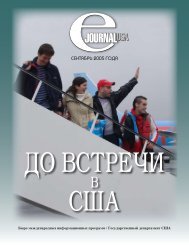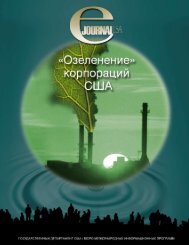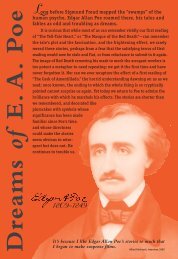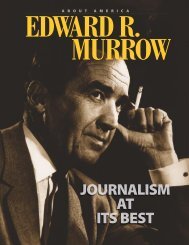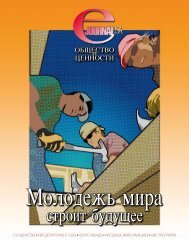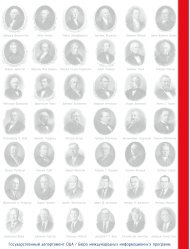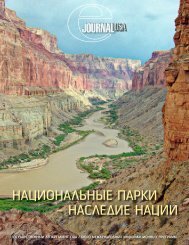AMERICAN
Outline of American Literature
Outline of American Literature
- No tags were found...
Create successful ePaper yourself
Turn your PDF publications into a flip-book with our unique Google optimized e-Paper software.
ZORA NEALE HURSTON<br />
Photo © Carl Van Vechten,<br />
courtesy Yale University<br />
Zora Neale Hurston<br />
(1903-1960)<br />
Born in the small town of<br />
Eatonville, Florida, Zora Neale<br />
Hurston is known as one of the<br />
lights of the Harlem Renaissance.<br />
She first came to New York City at<br />
the age of 16 — having arrived as<br />
part of a traveling theatrical troupe.<br />
A strikingly gifted storyteller who<br />
captivated her listeners, she attended<br />
Barnard College, where she<br />
studied with anthropologist Franz<br />
Boaz and came to grasp ethnicity<br />
from a scientific perspective. Boaz<br />
urged her to collect folklore from<br />
her native Florida environment,<br />
which she did. The distinguished<br />
folklorist Alan Lomax called her<br />
Mules and Men (1935) “the most<br />
engaging, genuine, and skillfully<br />
written book in the field of<br />
folklore.”<br />
Hurston also spent time in Haiti,<br />
studying voodoo and collecting Caribbean<br />
folklore that was anthologized<br />
in Tell My Horse (1938). Her<br />
natural command of colloquial English<br />
puts her in the great tradition<br />
of Mark Twain. Her writing sparkles<br />
with colorful language and comic<br />
— or tragic — stories from the<br />
African-American oral tradition.<br />
Hurston was an impressive novelist.<br />
Her most important work,<br />
Their Eyes Were Watching God<br />
(1937), is a moving, fresh depiction<br />
of a beautiful mulatto woman’s<br />
maturation and renewed happiness<br />
as she moves through three marriages.<br />
The novel vividly evokes the<br />
lives of African-Americans working<br />
the land in the rural South. A harbinger<br />
of the women’s movement,<br />
Hurston inspired and influenced<br />
such contemporary writers as Alice<br />
Walker and Toni Morrison through<br />
books such as her autobiography,<br />
Dust Tracks on a Road (1942).<br />
LITERARY CURRENTS: THE<br />
FUGITIVES<br />
AND NEW CRITICISM<br />
From the Civil War into the<br />
20th century, the southern<br />
United States had remained a<br />
political and economic backwater<br />
ridden with racism and superstition,<br />
but, at the same time, blessed<br />
with rich folkways and a strong<br />
sense of pride and tradition. It had<br />
a somewhat unfair reputation for<br />
being a cultural desert of provincialism<br />
and ignorance.<br />
Ironically, the most significant<br />
20th-century regional literary<br />
movement was that of the Fugitives<br />
— led by poet-critic-theoretician<br />
John Crowe Ransom, poet Allen<br />
Tate, and novelist-poet-essayist<br />
Robert Penn Warren. This southern<br />
literary school rejected “northern”<br />
urban, commercial values, which<br />
they felt had taken over America.<br />
The Fugitives called for a return to<br />
the land and to American traditions<br />
that could be found in the South.<br />
The movement took its name from<br />
a literary magazine, The Fugitive,<br />
published from 1922 to 1925 at<br />
Vanderbilt University in Nashville,<br />
Tennessee, and with which Ransom,<br />
Tate, and Warren were all<br />
associated.<br />
These three major Fugitive writers<br />
were also associated with New<br />
76




